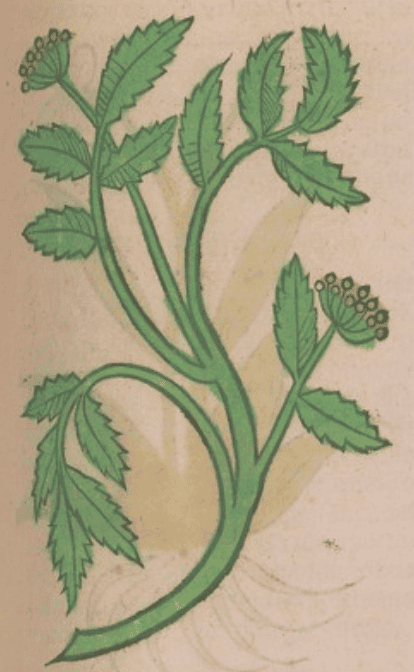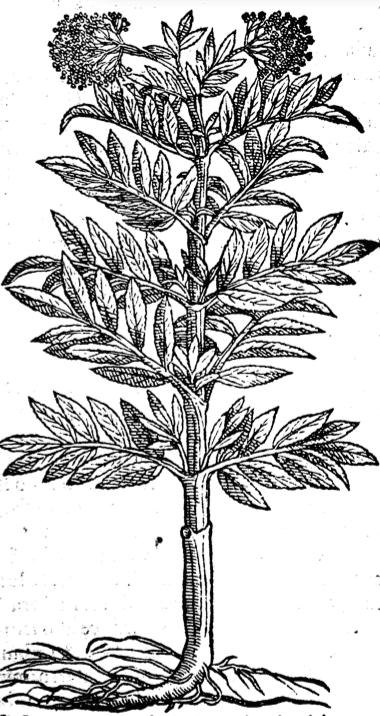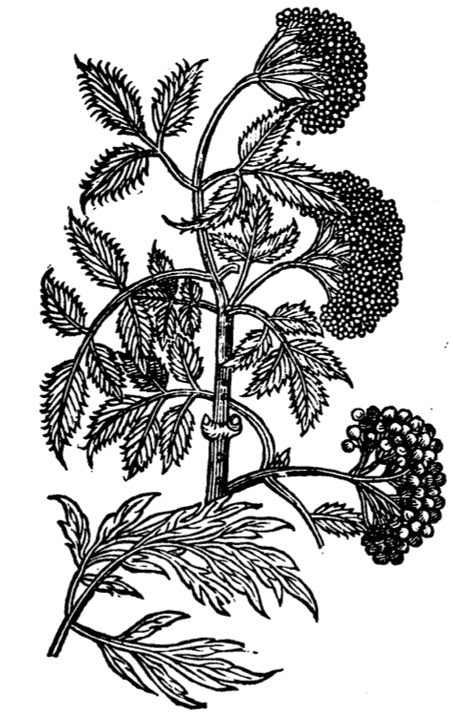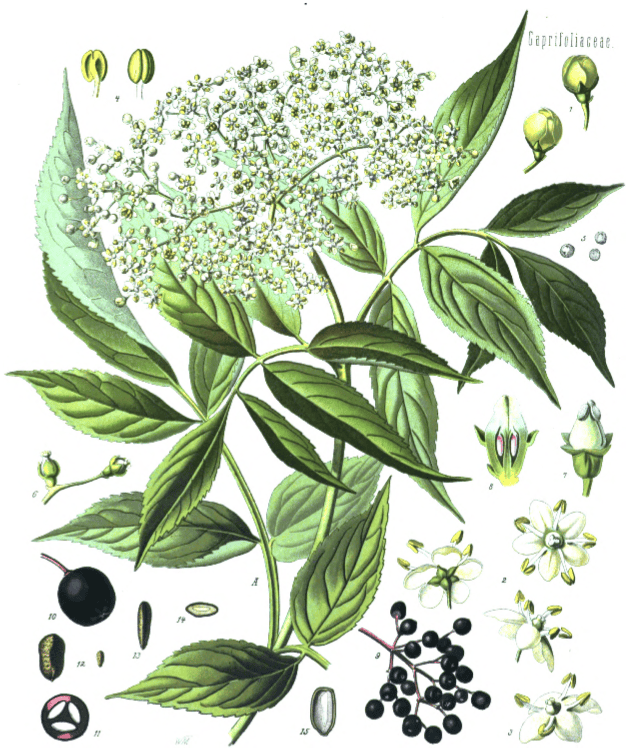Sambucus Flos, Elder Flower
 Ortus Sanitatis, Meydenbach, 1491
Ortus Sanitatis, Meydenbach, 1491

|

|
|
Della Materia Medicinale, Andrea Valuassori, 1562 |
‘Common’ and ‘Jagged’ Elder Parkinson, Theatrum Botanicum, 1640 |
 Koehler’s Medizinal Pflanzen, 1887
Koehler’s Medizinal Pflanzen, 1887Botanical name:
Sambucus nigra
Parts used:
Flower
Temperature & Taste:
Cool, dry. Pungent, Sweet
Classifications:
2B ATTENUATERS. 2F. PURIFYING. 2J. RAREFYING. 2L. EMOLLIENT. 2Q. ANODYNE
3A. SUDORIFICS & DIAPHORETICS
4a. CEPHALIC
TCM:
A. Clear the Exterior
Uses:
1. Clears Wind and Heat, Resists Poison:
-Colds, Influenza, Sore Throat, Sinusitis, Nasal congestion or discharge. (Commission E approved for Colds; BHP for Fever)
-Eruptive Skin diseases such as Measles and Scarlet Fever
-sore, red, or itchy Eyes.
-Cholera, Diarrhea and summer complaints.
-Syphilis, Eczema, Psoriasis, Erysipelas, Lupus erythematosus and other skin diseases (both internally and externally)
-traditionally taken in Spring tonics.
2. Clears Phlegm, Stops Cough and Wheezing:
-excessive phlegm with Cough and Wheezing as seen in Bronchitis, Asthma and Pneumonia.
-Flowers have been boiled in Milk for Cough
3. Clears Wind-Heat, Stops Spasms:
-Epilepsy; Headaches
-Spasms, and twitching of the Eyelids
-Paralysis
4. Clears Phlegm, Resolves Swellings:
-Phlegm swellings including Scrofula, swollen Glands and Nodes.
–skin growths including Cancer (used both internally and externally).
5. Externally:
-Elder Flower Water was much used for the skin as a cosmetic
-flowers were used in preparations for Erysipelas, Burns and Scalds.
-various skin inflammations
-Mouth Ulcers (as a gargle).
Dose:
Infusion or brief Decoction: 3–5 grams (10–15 grams daily)
Powder: 2–4 grams
Tincture (1:5): 2–7 mls, typically 30–60 drops, 2–3 times daily
Fluid Extract (1:1): 1½–3 mls.
Comment:
1. Schroder relays the story of Dr. Martin Bolchwizt, who, in his Anatomy of the Elder, said the Elder could be used to cure most diseases. This has been carried on today where it is often said ‘the Elder is a medicine chest in itself’.
2. All parts have an ‘opening’ (purgative) effect. The Leaf and Flower are mildest in function, and principally promote Sweat. Next the Berries which are best to promote Urine; the Bark or Root bark is more powerful being laxative, and in full doses the inner bark is a hydragogue cathartic.
3. For some indications, different authors used different parts for the same purposes, especially to promote Urine which can be treated by any part of the plant.
4. In Summary:
i. Flowers are principally Diaphoretic, used in acute diseases and Fevers, as well as Cough, Bronchitis, Sore Throat, Asthma and Wheezing
ii. Juice, Tincture or Infusion of the Flowers are sedative and relieve pain
iii. Leaf in general can be used as the Flower, but is stronger to promote Urine.
iv. Berries promote Urine, are slightly tonic, and also resolve Swellings.
v. Bark and Root bark are Diuretic in Edema and Urinary disorders, and Arthritic disorders. Full doses are Cathartic
Main Combinations:
1. Colds, Flu; and to promote Sweat:
i. Elder flower is traditionally combined with Peppermint
ii. Elder flower with Peppermint and Yarrow
iii. Heat-type Cold or Flu, strong infusion of Elder flower with Lemon juice
iv. Elder Flower, Elder Berry, Elecampane, Mullein, Rose hip
v. Species Diaphoretic, Elder flower with Linden flower, Mullein flower (German)
vi. Sudorific Vinegar, Elder flower with Sarsaparilla, China root, Sassafras, Cassia wood (as in Sudorific Vinegar)
2. Acute Viral Infections, Elder flower with Balm and St. Johns wort
3. Chicken Pox, Elder flower with Senna, Yarrow, Pleurisy root and Ginger (The Medical Herbalist)
4. Erysipelas, Elder flower, Yarrow, White Poplar bark, Blessed Thistle
5 Stuttgart Water tea: Elder flower with Caraway, Parsley seed, Juniper berry, Squill (Hager)
6. Promote Urine and Break stones, Elder flower with Bitter Almond, Peach kernel and Cherry kernel (as in Diuretic Water of Frankfurt)
7. Kneipps Blood Purification Tea: Elder flower with Dwarf Elder root, Sandalwood, Mistletoe, Nettle, Strawberry leaf, Sloe flowers, Juniper shoots
8. Arthritis:
i. Conserve of Elder flowers (Herbarium Horstianum, 1630)
ii. Elder flower with Willow bark, Rosemary, Golden Rod, Coltsfoot (as in Decoction for Arthritis)
9. Rheumatism, Elder flower with Birch leaf, Linden and Nettle (Tschirner)
10. Scrofula, Elder flower, Walnut leaf
11. Cancer, Elder flower with Herb Robert, Agrimony, Tormentil, Rosemary (as in Decoction for Cancer)
12. Gargle:
i. Elder flower with Sage
ii. Elder flower with Mullein
iii. Elder flower with Syrup of Mulberry
13. As a Fomentation, Infusion of Elder flower with Spirit of Camphor.
Major Formulas:
Wine for Catarrh
Decoction for Arthritis
Sudorific Vinegar
Decoction for Cancer (Fuller)
Cautions:
Generally Safe.
Main Preparations used:
Distilled Water of the Flowers, Spirit of the Flowers (fermented), Wine of the Flowers, Infused Oil, and a Distilled Oil.
1. Vinegar of Elder:
i. Elder flowers (1 part), Vinegar (12 parts). Macerate 4 days, clarify, filter.
2. Oxymel of Elder:
i. Vinegar of Elder (1 part), Honey (2 parts). Boil slowly to a syrup. (Pharmacopoeia Herbipolitania, 1796)
3. Elder-flower Water:
i. Elder flower (1 part), Water (4 parts), distil off 2 parts. (Pharmacopoeia Gallica, 1818)
ii. Elder flowers (3 parts), Water (12 parts). suspend the flowers in a bag in the middle of the cucurbit so it doesnt touch the water. Distil 6 parts. (Dispensatorium Fuldense, 1791)
4. Spirit of Elder:
i. Elder flower (1 part), Proof Spirit (4 parts). Macerate 3 days, distil one-half. (Dispensatorium Pharmaceuticum, 1777)
5. Elder Oil:
i. Elder flower (1 ½ part), Olive oil (3 parts). Digest 2 days in a water bath, cool, express. Repeat with fresh flowers. (Pharmacopoeia Sardoa, 1773)
6. Elder Ointment:
i. Elder flower, prepared Lard (2 lbs. each). Boil the flowers in the lard until crisp, strain.
-
Extra Info
-
History
|
‘There are two kinds of elder, one of which grows wild and is much smaller than the other; by the Greeks it is known as the “chamaeacte,” or “helion.” A decoction of the leaves, seed, or root of either kind, taken in doses of two cyathi, in old wine, though bad for the upper regions of the stomach, carries off all aqueous humours by stool. This decoction is very cooling too for inflammations, those attendant upon recent burns inp articular. A poultice is made also of the more tender leaves, mixed with polenta, for bites inflicted by dogs. The juice of the elder, used as a fomentation, reduces abscesses of the brain, and more particularly of the membrane which envelopes that organ. The berries, which have not so powerful an action as the other parts of the tree, stain the hair. Taken in doses of one acetabulum, in drink, they are diuretic. The softer leaves are eaten with oil and salt, to carry off pituitous and bilious secretions. |
‘The smaller kind is for all these purposes the more efficacious of the two. A decoction of the root in wine, taken in doses of two cyathi, brings away the water in dropsy, and acts emolliently upon the uterus : the same effects are produced also by a sitting-bath made of a decoction of the leaves. The tender shoots of the cultivated kind, boiled in a saucepan and eaten as food, have a purgative effect : the leaves taken in wine, neutralize the venom of serpents. An application of the young shoots, mixed with he-goat suet, is remarkably good for gout; and if they are macerated in water, the infusion will destroy fleas. If a decoction of the leaves is sprinkled about a place, it will exterminate flies. “Boa” is the name given to a malady which appears in the form of red pimples upon the body; for its cure the patient is scourged with a branch of elder. The inner bark, pounded and taken with white wine, relaxes the bowels.’ (The Natural History of Pliny, trans. by Bostock and Riley, Vol. 5, 1856) |
